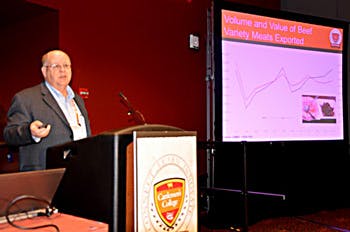Cattlemen’s College Session Highlights Value of Export Markets

Paul Clayton explains how exports of beef variety meat and other offal add value to every carcass
Producers attending the Cattle Industry Annual Convention in San Antonio this week received a comprehensive overview of how international markets add revenue to their bottom line. A breakout session of the annual producer education series “Cattlemen’s College” featured a panel of experts who gave a detailed explanation of how exports of beef and beef products have grown in recent years, and why the future is bright for further expansion.
One of the speakers was Paul Clayton, USMEF senior vice president for export services. Clayton’s presentation focused on the growing value of the drop credit, which he defined as all parts of the animal that are not kept with the carcass – including variety meat, hides, rendered products and items used for pet food and pharmaceutical products.
Clayton noted that the drop credit has recently posted impressive gains, adding critical value to every carcass.
“We’ve picked up an additional $36 on the drop credit in the just the past two years, so it’s now approaching $220 per head,” Clayton explained. “And it’s grown into a $5.1 billion industry.”

(from left to right) Dr. Larry Corah, Jay Theiler and Paul Clayton field questions from cattle producers about the value of export markets
Clayton also gave examples of major destinations for U.S. beef variety meat, highlighting the popularity of tongues in Japan and Mexico, livers in Egypt and hearts and tripe in Peru.
Clayton was joined on the panel by Dr. Larry Corah, vice president of production for Certified Angus Beef (CAB), and Jay Theiler, executive director of marketing for Agri Beef Co.
Corah explained that CAB currently produces about 882 million pounds of beef per year, and 13.5 percent of this total (about 120 million pounds) is exported.
“Exports are already extremely important to the premium side of the beef industry, but I believe you will see a big uptick in the next 10 to 15 years,” he said. “The upside potential is immense.”
While CAB’s largest international markets are Canada, Mexico, Hong Kong, Japan and South Korea, the company currently ships to more than 80 countries. Corah noted that CAB greatly diversified its international marketing efforts when the Japanese market was closed due to BSE, and has achieved significant growth in Peru, Chile, Colombia and several markets in the Caribbean.
Theiler explained that Agri Beef Co. currently exports to about 30 countries, with growing incomes and a rapidly expanding middle class making Asian markets especially attractive. But he also outlined some of the challenges exporters face in these markets, including technical barriers and high tariff rates. Theiler noted that the West Coast port labor dispute has created serious problems for exporters in recent weeks.
“Up and down the West Coast, nothing is moving,” he said. “We can’t ship to Asia, so the premiums aren’t there – and this is definitely impacting cattle prices. It also becomes a long-term problem when buyers turn to alternative suppliers. We hope to win all that business back, but there are no guarantees.”
Theiler said even when the port labor contract dispute is resolved, it could take 45 days for shipping traffic to return to normal.
